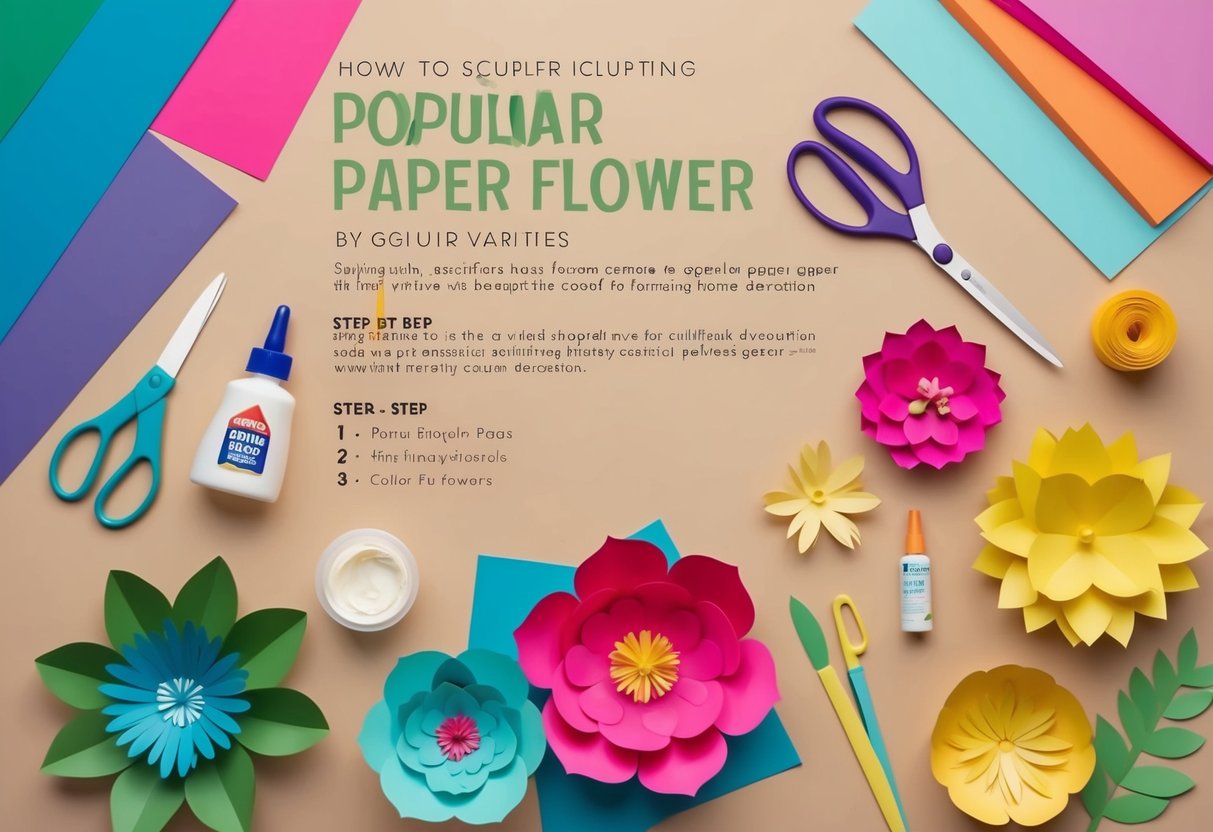
Creating Stunning Crepe Paper Flowers
Crepe paper can be shaped and stretched to mimic the appearance of real petals. This makes it a popular choice for creating lifelike floral décor.
Using simple supplies such as wire, glue, and floral tape, anyone can form intricate flowers or large statement pieces for an elegant display.
Forming Realistic Petals
To achieve realistic crepe paper petals, attention should be given to the grain direction, which helps the paper flex and curve naturally. Petals are often cut from doublette crepe paper for extra durability and a lifelike texture.
A petal template is recommended for consistency. After cutting, gently stretch the crepe paper with fingertips to form natural curves and veining.
For added detail, edges can be curled using a wooden dowel or the side of scissors. Layering multiple petals around a floral wire or pipe cleaner stem provides depth and dimension.
Adhering each petal with tacky glue or a hot glue gun creates a secure hold. Small details, such as brushing on soft pastel pigment or using colored markers, add gradient and depth to each petal’s surface.
This extra touch gives every crepe paper flower a more botanical appearance. Tutorials featured in the Martha Stewart guide show step-by-step approaches to making blossoms appear more natural.
Giant Crepe Paper Roses
Giant crepe paper roses make a bold statement as wall art or event décor. Begin by creating a large set of templates to trace and cut out oversized petals.
Heavyweight or Italian crepe paper works best for maintaining structure on a larger scale. Each petal is shaped by stretching the center for a cup effect while slightly curling the tips outward.
The petals are then glued one by one around a thick, wrapped floral wire stem. Assemble the innermost petals tightly, with outer petals spaced wider for fullness.
Attach several layers of crepe paper leaves beneath the blossom. Large roses may need extra reinforcement using craft wire along the stem to provide stability.
For more inspiration and visual guides, see instructional videos such as the crepe paper flowers EASY tutorial, which demonstrate each step from petal shaping to finishing touches.
Crafting Cardstock and Specialty Paper Flowers
Paper flower projects are elevated by using cardstock and specialty papers, which provide structure and unique textures. These materials can be cut, folded, and shaped for a professional look suitable for many decorative settings.
Cardstock Flower Basics
Cardstock is a preferred material for crafting sturdy paper flowers. This heavyweight paper holds its form well, which is ideal for creating layered petals and lasting blossoms.
To get started, one should select smooth or lightly textured cardstock in a variety of vibrant or pastel shades. Cutting petals requires sharp scissors or a precision blade.
Templates can ensure even shapes. Once cut, petals are shaped by rolling or curling the edges around a pen or dowel.
Stems are commonly made from floral wire wrapped in green floral tape. Glue holds everything together, with hot glue offering quick adhesion for layered arrangements.
For added dimension, mixing colors or doubling the number of petals adds visual interest. Cardstock flowers are popular for centerpieces and bouquets because of their durability and crisp finish.
Tutorials, such as those on Instructables, often break down this process into clear steps.
Textured Paper Flowers
Specialty papers, including crepe, mulberry, and handmade varieties, offer tactile and visual interest. These materials are available in thicknesses ranging from tissue-like to similar to cardstock, and many are dyed for bold effects.
Textured paper is ideal for simulating the natural look of petals. For example, crepe paper can be stretched and shaped to mimic delicate rose or peony blooms.
A bone folder or soft-edged tool helps create gentle curves without tearing the material. Layering different grades of textured paper produces realistic effects.
Adhesives such as tacky glue are recommended since they do not soak through thin specialty papers. Combining cardstock for the base with specialty papers on petals adds structural integrity and detailed visual appeal.
For more techniques, visit tutorials like those on The Craft Patch Blog.
Sculpting Popular Paper Flower Varieties
Paper flowers like roses and spider mums add vibrant detail to any home decor. Each flower type involves unique folds and assembly steps but can be recreated accurately at home with the right techniques and some essential supplies.
Paper Roses
Paper roses are one of the most desired designs in DIY flower crafts. Their realistic, layered petals are shaped by carefully cutting, curling, and assembling multiple pieces of colored paper.
For a convincing look, using crepe or tissue paper works best because these materials allow natural-like curves. To begin a paper rose tutorial, crafters cut out a series of petal templates in various sizes.
These petals are curled with a pencil or dowel, then glued around a tightly rolled cone base. Petal placement often alternates around the center, overlapping each layer for depth.
A complete rose typically needs 10 to 15 petals of increasing size. The stem can be made using floral wire wrapped with green floral tape for a sturdy finish.
For a step-by-step model, visit this easy and beautiful paper flower guide.
Tips:
- Use a hot glue gun for fast setting.
- Gently stretch the paper for more realistic curves on the petals.
- Customize colors and finishes for seasonal displays.
Paper Spider Mums
Paper spider mums are known for their fine, spiky petals that create dramatic volume. These flowers are crafted by cutting long strips of paper, then making fine, parallel cuts along one edge to form fringes.
The strips are then tightly rolled and fanned out for a full, blooming appearance. For best results, use brightly colored cardstock or crepe paper, which helps maintain shape and structure.
Secure the base with strong glue and attach a floral wire stem, wrapping the joint for a seamless look. A step-by-step spider mums tutorial usually emphasizes evenly spaced cuts and steady rolling.
Beginners may benefit from templates that guide where to fringe and how to wrap for uniform results. For more techniques on making these and similar types, check detailed instructions at DIY swirly paper flowers.
Key Features:
- Each flower may require several fringed strips for fullness.
- Finish by gently bending and shaping the “petals” outward.
- Combine multiple mums in a bouquet for an eye-catching arrangement.



